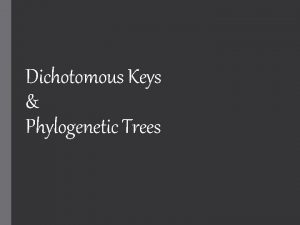Dichotomous Key Notes Dichotomous Keys Dichotomous Divided into










- Slides: 10

Dichotomous Key Notes

Dichotomous Keys Dichotomous: Divided into two parts. Dichotomous Key: A tool used to identify living things by making choices between 2 sets of structural adaptations.

Dichotomous Key Article https: //drive. google. com/open? id=1 j. Bbp. V 6 f. CJ 8 s -7 ce. IQNm. J 8 w. B 9 ju. Fc 5 y. J 2

Tips for using a dichotomous key • Choose one organism. • ALWAYS Start with #1 and follow instructions until you identify the organism. • If you are unsure of an adaptation that is being described, then compare to other organisms or consult instructions/ diagrams. • Once you are finished identifying your first organism, choose another. • Begin with Step 1 every time you begin to identify a new organism.

Find the species name for the dog the house cat, and the polar bear 1 a If family is Ursidae- go to 2 1 b If family is not Ursidae– go to 3 2 a If coat color is Black 2 b If coat color is White – Ursus horribilus Ursus arctos 3 a If family is Canidae- go to 4 3 b If family is Felidae- go to 5 4 a If coat color is Black & grey – Canis lupus 4 b If coat color is white with brown spots- Canis familiaris 5 a If genus is Panthera 5 b If genus is Felis- go to 6 6 a If coat is Gray 6 b If coat is Tan with spots & stripes- Panthera pardus Felis catus Felis pardalis Challenge: can you re-create this DK with less steps?

Insect Guide

1 2 4 5 3 4 6

Leaf Guide


Tips for creating your own dichotomous key Step 1 - find a characteristic that divides your group into two major groups. NO organism can fall into both groups! 1 a- go to step 2 1 b- go to step ____. (this step will be created after you have identified all organisms that fit into the 1 a classification) Step 2 - identify all organisms that fit into this group (you may use multiple steps) before you begin to identify organisms that fit into 1 b.
 Dichotomous keys split choices into parts.
Dichotomous keys split choices into parts. Priesthood keys restored in kirtland temple
Priesthood keys restored in kirtland temple Keys to content writing
Keys to content writing Taxonomic key
Taxonomic key Classification and dichotomous key
Classification and dichotomous key Why is it called a dichotomous key
Why is it called a dichotomous key Whats a dichotomous key
Whats a dichotomous key Dichotomous keys are constructed based on
Dichotomous keys are constructed based on Introduction to dichotomous keys
Introduction to dichotomous keys Infinitives latin
Infinitives latin Gsm network divided into
Gsm network divided into

















